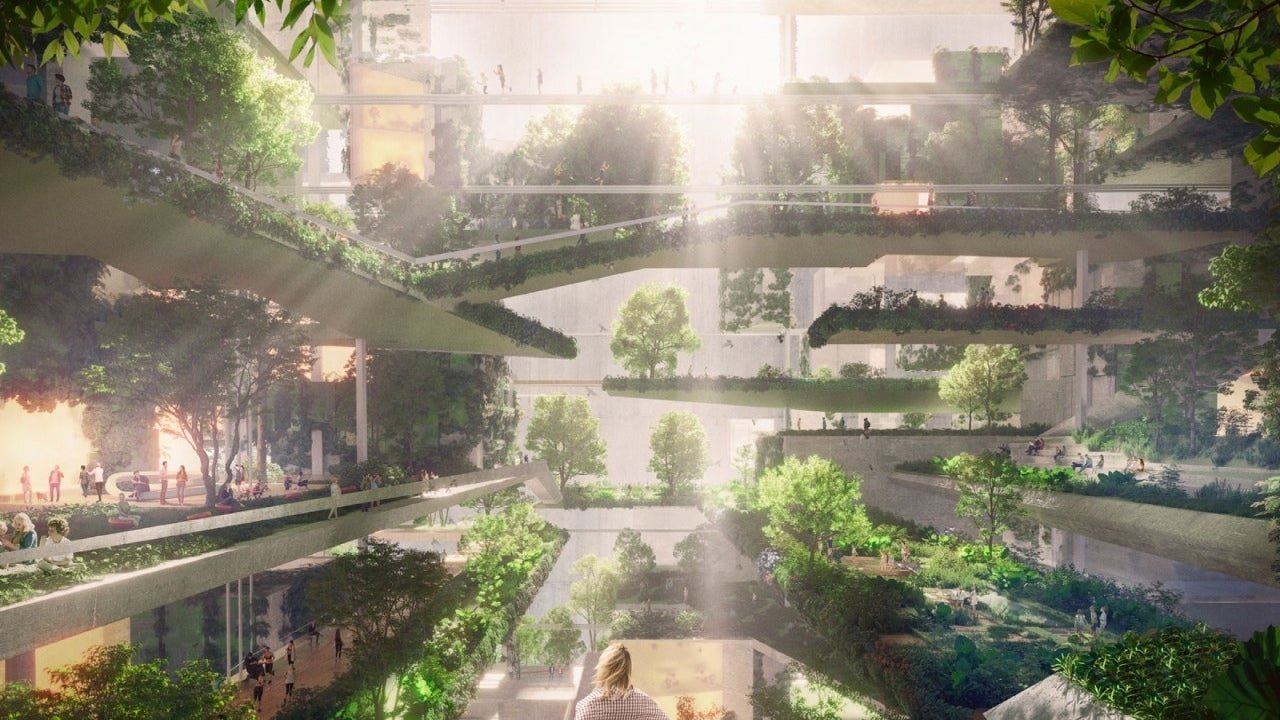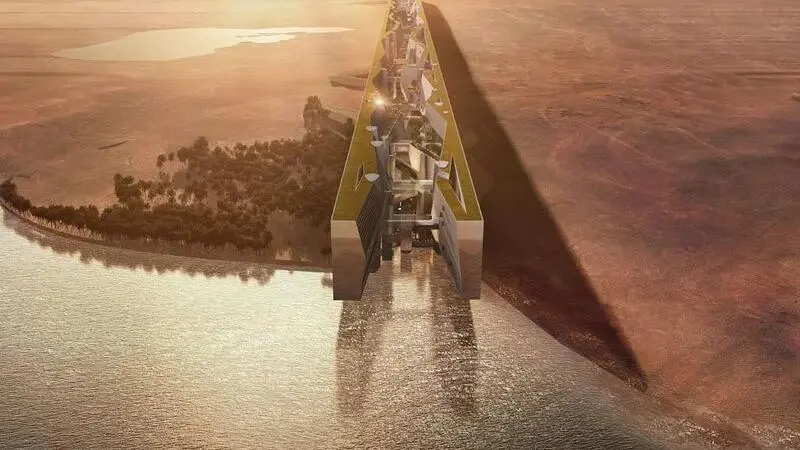NEOM, Saudi Arabia’s groundbreaking mega-project, is poised to become the world’s most ambitious green city—a futuristic metropolis that promises to revolutionize urban living. Envisioned as a cornerstone of Saudi Vision 2030, NEOM is a $500 billion development that stretches across 26,500 square kilometers in northwestern Saudi Arabia. With a strong focus on sustainability, innovation, and technology, NEOM aims to set new global standards in urban planning and environmental stewardship.
Designed as a city of the future, NEOM is a bold experiment in how cities can operate in harmony with the environment while offering its residents a high-tech, sustainable lifestyle. From renewable energy to smart infrastructure and sustainable urban design, NEOM is more than just a city—it is a blueprint for how societies might thrive in the face of climate challenges.
1. Vision 2030 and the Birth of NEOM
Launched as part of Saudi Arabia’s Vision 2030, NEOM reflects the Kingdom’s ambition to diversify its economy away from oil and develop new sectors such as tourism, technology, and renewable energy. This initiative aims to place Saudi Arabia at the forefront of innovation, sustainable development, and global competitiveness.
The name “NEOM” is derived from two words: “neo,” meaning “new” in Greek, and “m,” the first letter of the Arabic word “mustaqbal,” meaning “future.” This perfectly encapsulates the project’s goal of creating a new, forward-thinking city that leads the world in sustainability and modern living.
NEOM’s primary objective is to establish a global hub for innovation, entrepreneurship, and sustainable development. The project will incorporate cutting-edge technologies, renewable energy sources, and environmentally conscious designs, making it a model city for future urban centers around the world.
2. A City Powered by 100% Renewable Energy
One of NEOM’s most ambitious promises is to run entirely on 100% renewable energy. This commitment to sustainability is central to the city’s design and operation. NEOM plans to harness its abundant natural resources—such as solar, wind, and green hydrogen—to power the entire city.
Solar and Wind Energy: NEOM’s geographic location in northwest Saudi Arabia gives it access to abundant sunshine and strong winds, making it an ideal location for large-scale solar and wind farms. The city is expected to produce vast amounts of clean energy through solar photovoltaic panels and wind turbines, reducing its reliance on fossil fuels.
Green Hydrogen Production: NEOM’s renewable energy strategy goes beyond solar and wind. The city is also investing heavily in the production of green hydrogen, a zero-emissions fuel produced using renewable energy. In collaboration with Air Products and ACWA Power, NEOM plans to build one of the world’s largest hydrogen plants. The facility will produce 650 tons of hydrogen per day, positioning NEOM as a global leader in hydrogen energy.By integrating renewable energy into every aspect of its infrastructure, NEOM aims to achieve net-zero carbon emissions, making it a model for sustainable cities worldwide.

3. The Line: A Revolutionary Urban Design
At the heart of NEOM’s sustainable urban planning is The Line, an ambitious project that reimagines the traditional city layout. The Line is a linear city that stretches 170 kilometers in length, with zero cars, zero streets, and zero emissions. Designed to accommodate 9 million residents, The Line is expected to set new standards for urban living.
Vertical Living: The Line features a unique vertical city design, where buildings are stacked vertically, allowing for more efficient land use and preserving 95% of NEOM’s land for nature. By building upwards instead of outwards, The Line reduces urban sprawl, minimizes the environmental impact, and promotes biodiversity.
Walkability and Zero-Carbon Transportation: The city’s design eliminates the need for cars, as residents will be able to access all essential services within a 5-minute walk. For longer distances, The Line will feature a high-speed rail system that can transport residents across the city in just 20 minutes, reducing the need for private vehicles and cutting transportation emissions to zero.
Sustainable Infrastructure: The Line will also incorporate smart infrastructure, utilizing AI, IoT, and digital technologies to manage resources efficiently and reduce waste. By integrating technology with sustainable design, The Line will offer its residents a high-tech lifestyle while significantly reducing the city’s environmental footprint.
4. A Focus on Biodiversity and Nature Conservation
One of the key goals of NEOM is to restore and conserve nature. Unlike traditional cities that expand at the expense of the natural environment, NEOM aims to enhance biodiversity and protect ecosystems. With 95% of NEOM’s land preserved for nature, the city will focus on re-wilding areas and restoring damaged habitats.
Nature Reserves: NEOM will include protected nature reserves where wildlife can thrive without human interference. These areas will be home to diverse species of plants and animals, helping to protect endangered species and promote biodiversity.
Marine Conservation: NEOM’s coastal location along the Red Sea offers unique opportunities for marine conservation. The project includes the creation of marine reserves and coral reef restoration programs to protect the region’s fragile marine ecosystems from the impacts of climate change and development.
By prioritizing biodiversity and environmental restoration, NEOM seeks to create a harmonious balance between urban development and the natural world.

5. Pioneering Smart City Technologies
NEOM’s vision extends beyond sustainability to embrace cutting-edge technologies that enhance the quality of life for its residents. As a smart city, NEOM will integrate artificial intelligence (AI), big data, robotics, and IoT to create a seamless and highly efficient urban environment.
AI-Driven Services: NEOM aims to use AI to manage city services such as energy distribution, transportation, waste management, and public safety. By analyzing real-time data, AI will optimize resource allocation, reduce waste, and ensure that the city operates efficiently and sustainably.
Automation and Robotics: NEOM will also leverage robotics and automation in sectors such as healthcare, agriculture, and infrastructure maintenance. Robots will perform tasks ranging from delivering goods to maintaining public spaces, reducing labor costs and improving efficiency.
Internet of Things (IoT): IoT will be integrated into every aspect of city life, from smart homes to public infrastructure. This technology will enable real-time monitoring of water and energy consumption, waste levels, and air quality, allowing the city to adapt dynamically to the needs of its residents.
By combining sustainable design with advanced technology, NEOM aims to create a futuristic city where technology serves people and improves their quality of life while minimizing environmental impact.
6. Economic Diversification and Job Creation
NEOM is also a critical component of Saudi Arabia’s broader strategy to diversify its economy beyond oil. The city is expected to attract global investment and create 380,000 jobs across various sectors, including technology, renewable energy, tourism, and advanced manufacturing.
Innovation Hub: NEOM is being designed as a global innovation hub where researchers, entrepreneurs, and investors collaborate to develop new technologies and industries. The city’s focus on sustainability, renewable energy, and advanced technology makes it an attractive destination for companies seeking to be at the forefront of innovation.
Tourism: NEOM’s stunning landscapes, from the Red Sea coastline to desert mountains, offer tremendous potential for eco-tourism and adventure tourism. The city’s commitment to sustainability and environmental conservation will also appeal to tourists looking for sustainable travel experiences.
As a catalyst for economic diversification, NEOM will play a central role in Saudi Arabia’s transition to a knowledge-based, sustainable economy.
7. Challenges and the Path Forward
While NEOM is undeniably ambitious, the project faces several challenges. Developing such a large-scale, technologically advanced city from scratch presents logistical, financial, and environmental hurdles. The construction of NEOM requires significant infrastructure investments, as well as careful planning to ensure that the city’s environmental goals are met.
Moreover, attracting the global talent needed to drive NEOM’s innovation agenda will require international collaboration and robust partnerships with technology companies, research institutions, and governments.
Despite these challenges, the potential impact of NEOM is enormous. If successful, NEOM could set a global benchmark for sustainable urban development, inspiring other cities to adopt similar models and contributing to the fight against climate change.
Conclusion
NEOM represents the world’s most ambitious attempt to build a sustainable, smart city from the ground up. With its commitment to renewable energy, environmental conservation, and cutting-edge technology, NEOM is a blueprint for the future of urban living. By addressing the challenges of climate change, resource scarcity, and urban sprawl, NEOM is setting a new standard for cities worldwide.
Image Courtesy Notice
At The Storiez, we value the efforts of photographers, artists, and content creators. The images featured in our articles are sourced from various news portals and online websites. We strive to ensure proper credit is given wherever possible. If you are the rightful owner of any image used here and would like to request its removal or correct attribution, please feel free to contact us. We respect intellectual property rights and aim to address concerns promptly.

